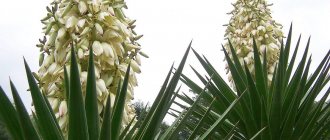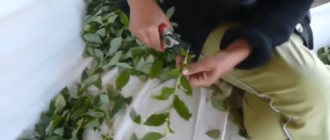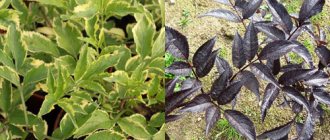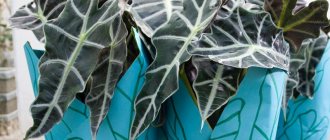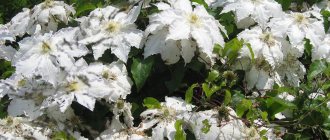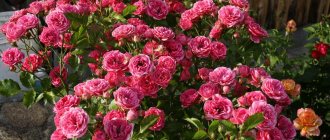Description of the plant
A plant of the Amaranth family, there are about 60 species in the genus, growth began in countries with warm climates. Perennial or annual plants (often classified as shrubs), its stems are straight and succulent, often with a red tint, ribbed. They can reach a height of 70 cm, with a minimum of 30 cm.
The leaves of the celosia flower are whole, smooth, arranged alternately, and have an ovoid shape with a pointed end. The color of the leaves can be variegated, dark purple or green.

Celosia flowers are bisexual, small, collected in paniculate or comb-shaped inflorescences. The fruit is a round capsule with black shiny round seeds.
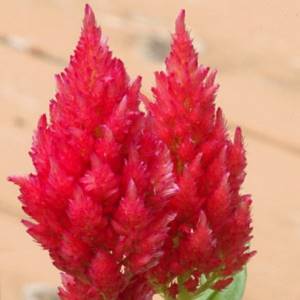
Description, types and varieties
Celosia belongs to the Amaranthaceae family; both perennial and annual flowers can be grown. The plant has straight branched stems on which alternate leaf plates are located. Their shape can be different: linear-lanceolate, ovoid or ovate-lanceolate. Spike-shaped, paniculate or comb-shaped inflorescences consist of many small flowers, their color can be red, yellow, orange, pink, golden or scarlet.
The following popular types and varieties are distinguished:
Argentia
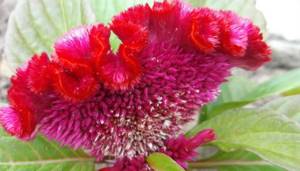
A perennial plant, the erect shoots of which usually do not grow more than 1 meter; specimens 30-65 cm in height are more often encountered. The veins on the dark green leaf blades stand out strongly; they are located alternately on the stem. The inflorescences resemble flames; the color of small flowers can be burgundy, white, crimson, pink, red, yellow or orange.
Comb

A perennial that is cultivated as an annual plant because it does not survive the winter. This species has another name - cockscomb, as it is popularly called for the unusual shape of the inflorescence, which actually resembles the comb of a rooster. The color of the flowers is quite bright; they are yellow, orange, purple, violet or pink.
Find out also about planting, growing and caring for freesia in the garden
Impress
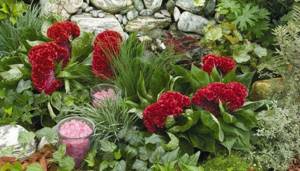
A perennial variety, which belongs to the type of comb celosia, the height of the erect stems is only about 20-30 cm. The leaf blades of the plant are small in size, but have an interesting dark purple or crimson color. Lush flowers stand out among the foliage; their bright burgundy color gives the plant a special decorative appearance.
You may also be interested: Secrets of growing Jameson's gerbera from seeds
Caracas
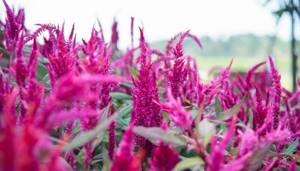
The plant is perennial, has branched stems, alternate leaf blades of a green hue. Small flowers form an inflorescence that resembles a spikelet in shape, the color of the petals is pink-purple. The variety is valued for its decorative value and is often grown as a houseplant. Flowering can be observed from the second ten days of July until October.
Carmina
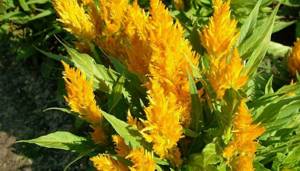
The variety was bred by US breeders; the pyramidal compact plant can reach 20-25 cm in height. Straight stems end in large paniculate inflorescences. Small flowers can be bright red, yellow, orange or deep red. This variety is often grown indoors.
Kimono

A well-branched, heavily leafy plant that can grow only 15 cm in height. The flower has densely double paniculate inflorescences, the color of which can be yellow, red, orange, burgundy or cream. The variety is cultivated in open and closed ground. The bushes begin to bloom profusely in June, and flowering begins to decline closer to mid-autumn.
Coral Garden

An annual crop with erect, rather thick stems, the height of which can reach 30-40 cm. The inflorescences in the form of a thick ridge make the plant decorative; the color of the flowers can be cream, purple, yellow, red or pink. You can enjoy flowering from mid-summer, but it lasts only until the first frost.
Paniculata
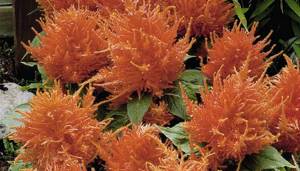
Some varieties of paniculata celosia can reach 1 meter in height, but there are stunted and dwarf specimens. Medium-sized leaf blades can have different colors from bright green to red or pink. Large panicle-shaped inflorescences are located on straight stems, their color is orange, yellow or red.
Pampas
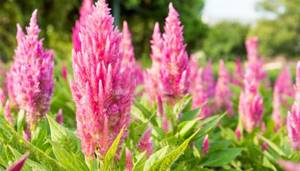
This variety looks quite elegant not only due to the unusual inflorescence, but also the decorativeness of the foliage. Erect stems can grow about 55 cm in height; feather-like inflorescences are located at their ends; the shade of the flowers can vary, from bright yellow to pale purple. Abundant flowering begins in the second decade of June.
Cirrus
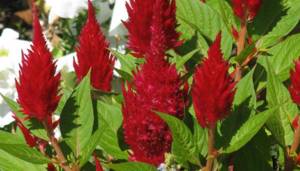
The plant is an annual, the height of the shoots can reach 55-65 cm, the leaves have a rich green color. The densely leafy stems end in pyramidal inflorescences; their color is predominantly red, only differing in shades. The bushes bloom profusely for 2-3 months; closer to October, the inflorescences begin to fade a little.
You may also be interested in: How to grow an eschscholzia flower from seeds
Silver
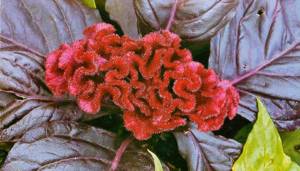
This species is popular in our country; the annual flower grows about 1 meter in height. Lush pyramidal inflorescences form on straight stems; their length can be a third of the entire height of the plant. The color of the petal varies, but is always quite bright. The decorative effect of the inflorescences lasts for 2-3 months, but ends with a decrease in temperature.
Photo gallery
Plant varieties
The most cultivated varieties or types of celosia:
- Celosia paniculata (silver celosia pinnate) has lush inflorescences, tall varieties reach a meter in height, the color of different parts of the plant can be very diverse.
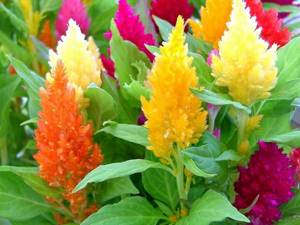
- Silver comb celosia - the flowers of this plant variety form an inflorescence very reminiscent of a cockscomb.
- Celosia spicata is cultivated much less frequently, but it is needlessly deprived of attention. Its inflorescences resemble spikelets. The colors are very different.
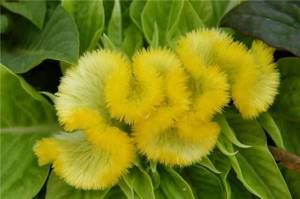
All types of plants are unique, beautiful, and can become an attraction in any area.
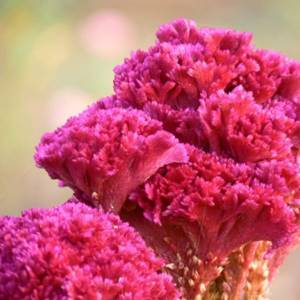
Varieties and types
The most famous is the type of celosia argentum , which includes celosia comb and pinnate (the latter is also called paniculate and plumosa.)
Celosia comb , known among us as “cockscomb”. The height of the flower is about 50 cm, but there are also lower varieties. The color of the leaves varies among different varieties; it can be green, dark red, gold, or bronze. The inflorescence is bright red and looks like a comb.
Celosia pinnate can grow to almost a meter, but there are also dwarf varieties. The leaves, in addition to green, are pink and scarlet. Flower color ranges from orange to shades of red.
If you purchased seeds with celosia mix , then you will grow a mixture of multi-colored varieties.
Popular varieties include celosia caracas , pamsam and gloryus . Caracas has a bright purple color, while Glorius is predominantly pink, but other colors also exist. Also attractive is the Pampas variety, which has large fluffy inflorescences in orange and red shades.
In addition, celosia can also be grown not only in the garden, but also indoors, for example, the carmine .
Celosia spica is still little grown in our countries, but nevertheless the demand for it has recently increased. Both tall (over a meter) and low (about 20 cm) varieties have been bred. Flowers look like spikelets, the color of which, in addition to the main colors of the inflorescences, is white.
Planting and propagation
Most often, celosia is propagated by seeds, and this is correct: cuttings can negatively affect the decorative characteristics of the flower. Purchasing mixtures of celosia varieties for planting is a very right decision. The area or balcony where the flower will grow will become unusually bright and rainbow-colored.
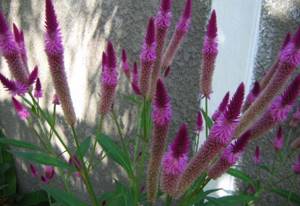
Reproduction and planting of a flower has a number of nuances:
- Celosia seeds are sown for seedlings under a film in March-April, planted at a distance of 5 cm on the surface of moist soil.
- On average, after 5 days the first shoots appear.
- Celosia, the cultivation of which requires careful care, needs a temperature of 18-20 degrees, ventilation and proper lighting.
- Watering should be moderate: do not over-water, do not over-dry.
- Seedlings are grown in a bright window, but protected from direct rays.
- Transplantation into open ground is possible only after the end of the spring cold, since celosia is a very heat-loving plant.
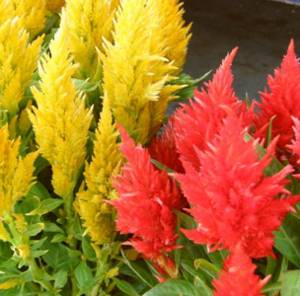
Fertilizing can be done once a month with mineral fertilizers. The main thing is not to forget about care, so as not to undo all previous work.
Sowing and picking celosia
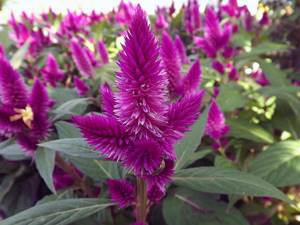
When to sow celosia seeds for seedlings depends on when you want to get flowering. Flowers sown in late March-early April will bloom in July. If you sow celosia in late February-early March, it will begin to bloom in June. In this case, the seedlings at home will need to be illuminated.
How to sow celosia seedlings step by step with video
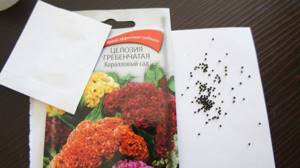
Small celosia seeds have a dense shell. To soften it before planting, it is recommended to keep them in a solution of any growth stimulant for 3-4 hours.
You can sow in a container or directly into individual cups. The disadvantage of sowing in cups is that not all seeds can sprout, so you will have to plant several seeds in one container. If all of them sprout, the seedlings will still have to be picked.
The soil for sowing celosia is suitable for universal use for seedlings.
Containers must have drainage holes. They are filled with moist soil and you can start sowing:
You will be interested to know: How to properly plant clematis in spring and autumn - instructions for beginners
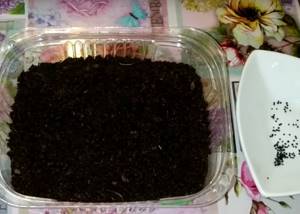
- Try not to sow small seeds too thickly so that in the future the seedlings do not interfere with each other.
- There is no need to sprinkle seeds on top. They are simply carefully moistened with lukewarm water using a spray bottle and the container is closed with a lid or cling film.

- Crops are harvested in a warm place , preferably on a bright windowsill, where there is no direct sunlight.
- Remove the cover every day to remove condensation and check the soil.
High-quality seeds, when sown correctly, will begin to germinate in 4-7 days. It is not recommended to immediately remove the lid from the container. Gradually accustom seedlings to the open air. Keep the soil moist, but do not overwater the celosia seedlings. When the top layer of soil dries, moisten it only with settled water. .

WATCH THE VIDEO OF SOWING CELOSIA FOR SEEDLINGS AND PICKING INTO CASSETTES
Picking celosia: videos and tips
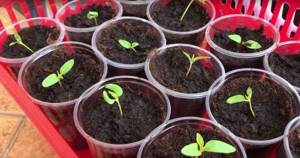
When growing celosia seedlings in a box or container, picking should be done twice:
- The first time the seedlings have 2 leaves, they are planted further apart in a wider container.
- The second time, celosia should be picked with 5-7 true leaves. By this time, the plants will have grown, become stronger and will grow well in individual pots.
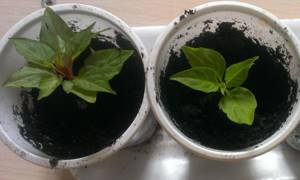
However, many gardeners immediately plant seedlings in separate glasses during the first picking. In this case, small plants in large cups take longer to develop, since they first need to grow roots according to the volume of the container.
Attention! Celosias have very fragile stems and roots, so replant them carefully.
WATCH THE VIDEO: HOW TO PICK CELOSIA CORRECTLY FOR THE FIRST TIME
Celosia care
Celosia comb and celosia paniculata equally require care. The first weeks after planting are important for celosia specifically in relation to watering: it should be plentiful, but not excessive. Further, if the summer rains, you should not water celosia daily (except on very dry days).

You shouldn’t overdo it with organic fertilizers and nitrogen: fertilizing more than once a month is no longer maintenance, but sabotage. In this case, the plant will grow very much, but the flowers will be small and unremarkable. This is especially visible in the photo in comparison with the flowers that were provided with proper care.

Planting Celosia
Fertile, loose soil with low acidity is preferable for the plant. It is necessary to ensure good drainage for celosia. If the soil is acidic, it is advisable to liming before planting. Dolomite flour and charcoal are suitable here. It is useful to add sand and humus to the soil. Young plants are planted carefully, simply transferring them from the container into the ground so as not to damage the roots.

How does celosia combine with other plants?
This plant is beautiful, bright, hardy, which made it popular. In principle, it is considered self-sufficient, so if there is no desire, it does not need to be mixed with other colors. But if you still decide to do this, you can mix celosia with literally all annuals.
- If you grow celosia comb, it will be balanced by flowers that are calmer and simpler in shape.
- If celosia is a bright accent, other flowers should be a little more subdued.
- The yellow-orange tones of paniculate celosia go well with the blue-violet Mexican aggregum.
- Bicolor ragwort is an excellent “companion” of celosia.
- White labelia will be a beautiful background to red celosia. The same variety of celosia goes well with ornamental cereals. However, do not forget that if caring for plants is different, you will have to follow its principles in relation to each to the right extent.
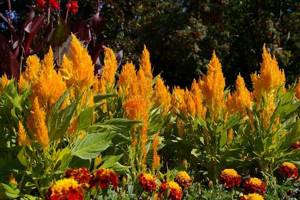
The charm of scallops in the garden, or the choice between seeds and seedlings
Undoubtedly, every amateur gardener wants to save money, so he prefers to sow the seeds himself in order to obtain seedlings. But few people take into account the need for proper and careful care at this time, as well as strict adherence to the rules of agricultural cultivation.
But those who decide to experiment on their own must take care of planting material. Undoubtedly, seeds can be sown after May 9 (when the threat of frost has passed) in open ground, in furrows with sand, and wait indefinitely for the result. Of course, everyone will wait for it, but such plants will not produce flowers until August. It makes sense? It makes no sense! Therefore, you need to either sow the seeds in a bowl early and grow celosia on the windowsill, or purchase ready-made seedlings.
Self-growing seedlings from seeds
The main thing here is to purchase good quality seeds. It is worth paying attention to professional seeds if you want to sow low-growing, variegated varieties. Otherwise, you can give preference to self-harvested varietal seeds, which will give excellent results.
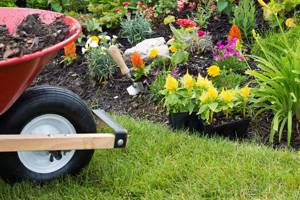
Celosia is planted in a flowerbed as seedlings
We omit the optimal option for growing sprouts from seeds in a greenhouse, because all the conditions are there (lighting, temperature, humidity). We are considering the option of growing it on a windowsill. In both cases, the sowing deadline is March 15-20 in order to get flowering plants in mid-June to early July.
You need to start with:
- soil preparation. Ready-made soil mixture is good, but only slightly acidic. A good option is 3 parts black soil, 2 parts sand, 1 part humus. We compact the soil in a box or bowl and spill it moderately;
- sowing It is better to do this in rows, the distance between which is 2-3 cm. This will make it easier to thin out ready-made seedlings, to plant them, and to save on the number of seeds;
- creating a microclimate in a box or bowl. To do this, cover the container with film or glass and open it only for watering. After emergence of seedlings, remove the cover. An important point is temperature. The optimal indicator for rapid (7-10 days) germination of celosia seeds is 25-28C;
- Picking plants after they produce a couple of true leaves. Many people skip this stage, but it is this stage that makes the plant powerful, “confident” in itself, the root system developed, the plant strong and healthy;
- planting in open ground somewhere from May 15-20, after warm weather returns outside.
Attention! For picking, it is not necessary to use free-standing cups cut from a polyethylene sleeve or PET bottles. Cassettes for seedlings with different numbers of cells provide a minimum usable area, ease of care and use, and the root system without damage.
As easy as shelling pears, or buying ready-made celosia seedlings
If you are not confident in your sowing abilities, or want to decorate your flower beds with ready-made plants “here and now,” go to the market or a specialized store, flower farm or nursery. Here you will be offered ready-made seedlings, which consist of 1 plant, planted in a separate cup or pot. There are often cases when already flowering celosia is sold.

Planting celosia
This is a great option to choose the color you like and arrange the flowerbed as required by the flower arrangement. What remains to pay attention to is the fresh green color of the foliage, the powerful stem, and the developed (but not outdated!) root system. To do this, just turn the plant over, hold it, shaking the root out of the pot: if the roots are milky white, uniform, without rot, take it. Otherwise, refuse.
Attention! Both seeds and seedlings should be purchased from, “Kitano”, “Sakata” and the like. Then you can be sure of an excellent result; your efforts will not be in vain.
How to use
One has only to look at a photo where this flower dominates or skillfully complements other plants on the site, and the desire to arrange such beauty in one’s garden area immediately arises.
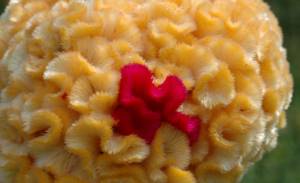
Comb celosia, like other varieties of this plant, can be planted in groups in prefabricated flower beds. You can also plant them in rows on ridges. Often the flower is grown in containers and vases, which immediately improves the area. But if celosia grows in an isolated container, care will be slightly different: the humidity of the substrate where the flower grows must be constantly maintained. Planting is not fundamentally different, no matter where the flower grows.
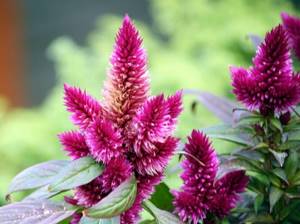
In a dark flowerpot it is better to grow a mixture of celosia varieties, and in a white flowerpot it is optimal to plant a plant of the same color, but very bright. It looks impressive both in the photo and in reality.
Celosia plant care
Celosia will develop and grow best in the sun. She needs warmth and protection from the wind. Maintenance procedures are simple - loosening the soil for better aeration of the roots and weeding.
Indoor care is also simple. The most important thing is to provide a bright and warm place and regularly ventilate the room. At home, I most often grow varieties of comb celosia.
Watering
The plant needs regular but moderate moisture. In hot weather, watering is increased and celosia is sprayed.
If there is a lack of moisture, the plant may not form flower stalks. And at the same time, you should not overwater the plant, observing the regime. This is especially true for young specimens. It is better to water early in the morning.
Winter hardiness
Celosia does not tolerate frosts, even light ones, so it is grown as an annual.
Top dressing
For celosia, complex mineral compositions are suitable; they are applied 3 times. in Week. Nitrogen fertilizers are suitable for seedlings, but in adult plants you need to be careful with them so that the greenery does not develop to the detriment of flowering. You cannot fertilize celosia with fresh organic matter.
Bloom
Blooms from July until frost.
